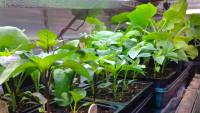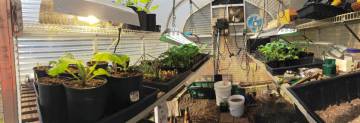Table of Contents
Potting
After the seedlings in a small tray or six-pack have their true leaves, I move them individually either to soil in a garden or to larger cells or pots. While some seedlings are ready to transplant to the soil (for example, onions, spinach or chard), most require potting so that their root systems can develop.
Directly to garden
I transplant smaller plants such as spinach, chard, parsley, even cabbages directly to garden soil, assuming it's ready and a suitable time, and they are hardened off. It takes planning to get these seeds ready when the soil is ready, so in the spring this applies to plants that tolerate cooler temperatures.
Potting medium
When I move the seedlings from the small flats and six-packs to larger containers I put a mixture of seeding mix, worm castings and complete organic fertilizer (COF) into the new pots. As with the plain seeding mix, I sift it through my half-inch sieve to remove clumps (and a few wood products I don't care to have).
| Seeding mix | Worm castings | COF |
|---|---|---|
| 1 cubic foot (7.5 gallons) | 2 quarts | 3 cups |
| 4 gallons | 1 quart | 1 1/2 cup |
Transferring to pots
 I compact the potting medium somewhat in the bottom of the pot. I find this keeps the root ball together when I later transplant to the soil.
I compact the potting medium somewhat in the bottom of the pot. I find this keeps the root ball together when I later transplant to the soil.
I transfer as much of the original root system and seeding mix as possible to the new pot or cell.
Irrigation
Then I irrigate the newly potted plants with a water and about 2% liquid kelp fertilizer (2 tablespoons liquid kelp in one gallon of water. On subsequent irrigation I include a similar amount of fish fertilizer with the liquid kelp.
As with germination I fill a 10“ x 20” tray with the nutrient mix and sit the pots into the tray. This waters the roots first and then the rest of the potting medium.
Hardening off
 I had wondered what would happen when all the germinating trays were full and I would start hardening off plants for transplanting.
I had wondered what would happen when all the germinating trays were full and I would start hardening off plants for transplanting.
A neighbor offered a 400W metal halide lamp and I took it, adding a third station for plants that I'm preparing for transplanting. The color temperature of this light hastens growth.
A 400-Watt metal halide grow light also warms this area, though only for about 10 hours a day.
 Before I expose the tender plants to the harsh variations of natural light and cool nights I alternate them between an unheated but well-lit station (at the left of the photo) in the greenhouse and outdoors on mild days.
Before I expose the tender plants to the harsh variations of natural light and cool nights I alternate them between an unheated but well-lit station (at the left of the photo) in the greenhouse and outdoors on mild days.
There's no heat mat here. I move the plants outdoors on sunny days and on cloudy days they still get good light and heat.
